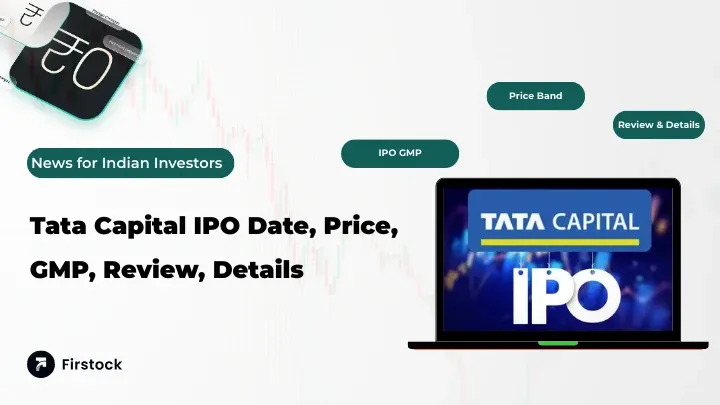Tata Capital IPO GMP – Firstock
Introduction
Have you been hearing a lot of buzz around the Tata Capital IPO lately? You’re not alone! The Tata brand is one of the most trusted names in India, and whenever a Tata company plans to go public, investors from all walks of life start paying attention. One of the hottest topics right now is the Tata Capital IPO GMP (Grey Market Premium) and what it could mean for early investors. Add to that the Tata Capital IPO shareholder quota, and you’ve got plenty of reasons to be curious.
Think of it this way: investing in an IPO is like buying tickets to a blockbuster movie before it hits theaters. You’re betting that the show will be a superhit, and the Tata Capital IPO has all the ingredients of one. In this guide, we’ll break down everything in simple, easy-to-understand language so that even if you’re new to the stock market, you’ll feel confident about the buzz surrounding this IPO.
Get insights on Tata Capital IPO, Tata Capital IPO GMP, and Tata Capital IPO shareholder quota. Stay updated with allotment, price trends, and more.
What is Tata Capital?
Tata Capital is a financial services company under the umbrella of the Tata Group, one of India’s most respected conglomerates. It offers a wide range of services including consumer loans, business finance, wealth management, and investment banking. Think of it as the financial arm of Tata, providing money solutions for individuals and businesses alike.
Overview of Tata Capital IPO
The Tata Capital IPO is one of the most anticipated offerings in recent years. Investors are excited because it allows them to own a piece of Tata’s financial services business, which has been growing rapidly. The IPO will give Tata Capital additional funds to expand its lending portfolio, strengthen its balance sheet, and meet regulatory requirements.
Why is Tata Capital Going Public?
There are multiple reasons behind Tata Capital’s decision to go public:
- Raising Capital: The IPO proceeds will help fund expansion and future projects.
- Meeting Regulatory Needs: RBI guidelines for NBFCs require strong capital adequacy.
- Enhancing Visibility: A public listing increases trust, transparency, and visibility.
- Value Unlocking: It allows Tata Group to unlock value and reward existing shareholders.
Tata Capital IPO Details
While exact numbers may vary closer to the issue date, here’s what we know:
- Issuer: Tata Capital Limited
- Parent Group: Tata Sons Pvt Ltd
- Expected IPO Size: Likely in multiple crores, one of the largest NBFC IPOs.
- Face Value: Typically ₹10 per share (to be confirmed).
- Price Band: Will be announced closer to the IPO date.
- Lot Size: Retail investors can apply in small lots.
Understanding IPO GMP (Grey Market Premium)
The Grey Market Premium (GMP) is an unofficial price at which IPO shares are traded before they officially list on the stock exchange. It acts as an indicator of investor sentiment.
For example, if the IPO price is set at ₹500 per share, and the GMP is ₹150, then people in the grey market are willing to pay ₹650 for the share even before listing.
Tata Capital IPO GMP Trends
Investors and analysts are keenly watching the Tata Capital IPO GMP because it provides early signals of demand. If the GMP is high, it suggests strong listing gains are expected. However, remember that GMP is not official and can fluctuate daily.
Tata Capital IPO Shareholder Quota Explained
The shareholder quota is a special reservation in IPOs for existing shareholders of the parent company. Since Tata Sons holds Tata Capital, it’s possible that shareholders of specific Tata companies (like Tata Motors, Tata Chemicals, etc.) may get preference. This makes the Tata Capital IPO shareholder quota a hot topic among investors.
Benefits of the Shareholder Quota
Why is this quota important?
- Better Allotment Chances: Retail demand often oversubscribes. Shareholder quota increases chances.
- Exclusive Access: Gives Tata shareholders a privileged entry.
- Loyalty Reward: A way for Tata Group to reward long-term supporters.
Should You Apply via Shareholder Quota?
If you already own shares of eligible Tata companies, applying through the shareholder quota could be beneficial. It’s like standing in a shorter queue when everyone else is rushing to the ticket counter.
Retail Investor Perspective
Retail investors look at:
- Listing Gains: Many apply just for short-term profit.
- Brand Trust: Tata Group’s credibility attracts first-time investors.
- Affordable Lots: Usually, IPOs allow small applications, making it easy for common investors.
Institutional Investor Perspective
Institutional investors focus on:
- Valuation Metrics
- Growth Potential of NBFC Business
- Market Share & Future Expansion Plans
Their participation often decides the overall subscription level of the IPO.
Risks Associated with IPO Investing
Even Tata IPOs are not risk-free. Consider:
- Market Volatility: Listing price can swing.
- Regulatory Challenges: NBFCs face strict RBI rules.
- Economic Slowdowns: Can affect loan growth and repayments.
Comparing Tata Capital IPO with Past Tata IPOs
Past Tata IPOs like Tata Consultancy Services (TCS) and Tata Motors DVR have seen massive success. Investors are hopeful that Tata Capital may follow the same path. However, unlike tech, finance is more cyclical and exposed to credit risks.
Expert Opinions and Market Sentiment
Market experts believe the Tata Capital IPO could attract heavy demand given the brand’s strong financial track record. Many brokerage houses expect strong subscription levels from all categories.
How to Apply for Tata Capital IPO
Applying is simple:
- Demat Account: Ensure you have one.
- UPI/ASBA Process: Use your bank or broker to apply.
- Select Quota: Choose retail, HNI, or shareholder quota.
- Submit Application: Before the deadline.
Tata Capital IPO Allotment and Listing Expectations
The allotment process is usually transparent and depends on demand. If the IPO is oversubscribed, lucky draw mechanisms apply. With Tata Capital’s brand value and high GMP expectations, analysts predict strong listing gains.
Final Thoughts
The Tata Capital IPO is shaping up to be one of the most awaited financial events in recent times. With high curiosity around the Tata Capital IPO GMP and excitement about the shareholder quota, it’s clear this IPO is not just about investing money—it’s about becoming part of the Tata legacy.
Like buying a golden ticket to a carnival, applying for this IPO could bring both joy and profits. However, always remember that stock market investments carry risks, and doing your research before applying is the wisest step.
FAQs
Q1: What is the Tata Capital IPO GMP?
The GMP (Grey Market Premium) is the unofficial trading price of Tata Capital IPO shares before listing. It indicates investor demand and expected listing gains.
Q2: Who is eligible for the Tata Capital IPO shareholder quota?
Shareholders of certain Tata companies (to be announced in IPO details) may be eligible for the shareholder quota, which improves allotment chances.
Q3: How can I apply for the Tata Capital IPO?
You can apply via your broker or bank using UPI/ASBA. If eligible, you can select the shareholder quota during the application process.
Q4: Is Tata Capital IPO good for listing gains?
Market sentiment and GMP trends suggest strong potential, but outcomes depend on final valuations and market conditions.
Q5: What risks should I consider before investing in Tata Capital IPO?
Risks include market volatility, regulatory pressures on NBFCs, and economic slowdown affecting lending business.







